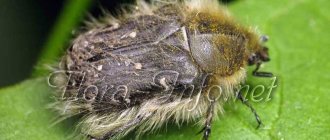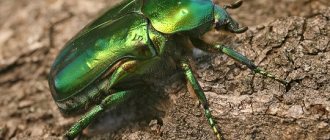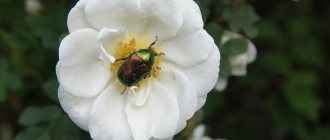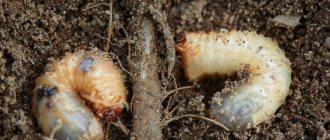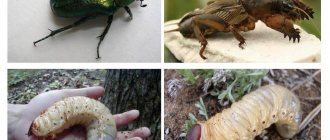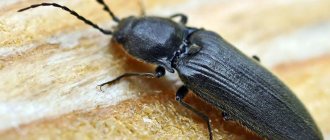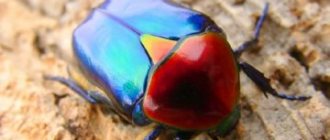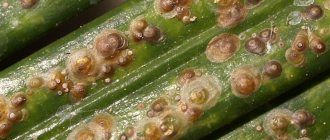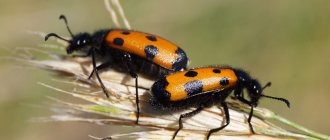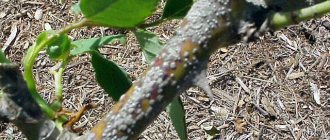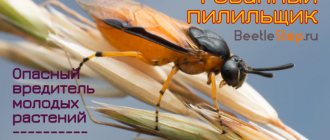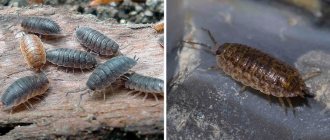A beautiful, golden, shiny, large beetle, even until recently (when there were very few of it) caused delight among flower growers.
But the population of the golden bronze was growing rapidly and the farmers realized that another disaster was approaching.
It is still believed that this species, unlike the hairy bronze, is not so terrible. The beetle comes out of hibernation late. By this time, the trees, as a rule, have faded. However, many crops are still in the flowering phase. Flower growers are also in panic; the beetle eats everything. How to deal with bronze grass, which eats the flowers of all the green spaces on the estate? Let's figure it out.
Principles of struggle
There is no absolutely accurate data on what kind of impact the green bronze grass is most susceptible to.
Until recently, the beetle did not pose a significant threat to gardens or vegetable gardens. Many summer residents are convinced that this type of insect cannot cause large-scale damage to plantings due to the relatively late summer - the plants have time to bloom by this period.
Advice! Although adults eat plants, the fight against them should begin with the destruction of the larvae.
Beetle larva
Large larvae of bronze moths inhabit rotten trees and humus heaps. If you promptly get rid of damaged wood and clear the area of fallen leaves, then the risk of an adult harmful “insect neighbor” appearing in the garden and beds in the future is reduced several times.
Important! At the same time, ecologists are sounding the alarm, since the bronzebacks are under threat of extinction. Conservationists recommend resorting to the destruction of bugs only in extreme cases
Methods for exterminating small parasites
There are several ways to get rid of green bugs. The techniques are not fundamentally different from those used to eliminate other similar pests.
Mechanical method. Bronze marks are removed manually. The action is performed according to the following algorithm:
- Cold water is generously sprinkled on a plant infested with a beetle (from the cold, the green bronze beetle loses activity and dexterity);
- spread an oilcloth under the tree, shake off the branches - the insects will fall off. You can collect beetles from low ornamental plants by hand: Collecting beetles by hand
- After collection, the beetles are placed in a vessel filled with kerosene liquid.
The technique is not highly effective. New bugs fly to the place of dead bronzes. But the method is used by those people who are opponents of spraying fruit plants with aggressive chemicals. The mechanical method is also used during the period of active flowering of plants.
Folk recipes. The method attracts with its safety for humans. Plants on which the May green beetle has settled are treated with various herbal decoctions. For example, solutions made from dandelions, tansy, and wormwood repel the pest. Beetles also don’t like garlic, onions, and horseradish, so they can also be actively used.
Chemical method. The essence of the technique is to apply various chemicals to plants infested with beetles or add pesticides to the soil in order to remove individuals that hibernate or spend the night in it.
Attention! It is prohibited to spray flowering trees with pesticides: this can kill beneficial insects that pollinate the garden. In this case, there is a possibility of being left without a harvest at all.
The following means are used:
- “Medvetox” - bury the drug to a depth of 3 - 5 cm in the soil, closer to the dark time of the day, when the green bronze begins to hide in the ground at night. The drug will destroy the bronze beetle, but will not harm the beneficial beetles.
- “Bazudin”, “Grom” or “Pochin” - added to manure heaps to destroy larvae.
- “Liquid” smoke - spray the crown (you can use a solution of green soap).
Important! Before use, you should carefully read the instructions. Be sure to follow the dosage and take personal protective measures against chemicals
Preventive methods include plowing the soil immediately after the winter period - this way you can get rid of hibernating bugs and prevent their active reproduction in the future.
You can look at the beetles and learn how to deal with them here:
Source https://beetlestop.ru/bronzovka-zelenaya/
Bronze beetles (Cetoniinae) are a subfamily of beetles belonging to the family Scarabaeidae. Includes five subspecies, which differ from each other in appearance and range. Within each subspecies, several forms are distinguished, differing in color and the presence or absence of hairs. These beetles are distributed throughout Eurasia, except for desert and mountain regions.
The bronze beetle is often mistaken for an ordinary cockchafer, since they belong to the same family. These insects can be distinguished by their bright metallic color and flight. When flying, the hard elytra of bronze beetles remain folded, unlike most beetles, and thin transparent wings are released through recesses on the sides. Therefore, despite their size, these beetles maneuver well in the air.
The most common are golden bronze, shaggy bronze and small green bronze.
Smooth bronzewort (Protaetia aeruginosa) and marbled bronzewort (Protaetia marmorata) are listed in the Red Book of the Moscow Region.
Bronzovka in the Red Book of the Moscow Region
Fiber's bronze or shiny ( Protaetia fieberi)
), which differs from the golden bronze by “a smooth, shiny, raised periosteal area of the elytra and a wide process of the mesothorax between the middle pair of legs.” It is clear that only an entomologist can determine the difference between these species. The golden-green (copper-red or light bronze) beetle most often lives in broad-leaved forests. Especially in oak ones. It feeds on tree sap and flowers. Its larvae live (and overwinter) in rotten wood of oak, poplar, willow and other deciduous trees. In the Moscow region, Fiber's bronze has become a very rare species: “The highest numbers are near the r.p. Boloomut, where you can observe 3 - 4 individuals per field season. To date, it has not been found in similar biotopes in Ozersky and Serebryano-Prudsky districts.” The brilliant bronze can be found in one of the reserves of the Serpukhov region and in the southeast of the region.
In addition to the golden bronzer, the smooth bronzer is included in the Red Book of the Moscow Region (Protaetia aeruginosa
) and marbled bronze (
Protaetia marmorata
).
It becomes uneasy to think that the population of the pretty golden bronze, the worst enemy of flower growers, also has a clear tendency to decline. “Irresponsible” gardeners (including me) are confidently approaching the day when this beetle will be listed in the Red Book.
A. Anashina. Blog, www.site
Website, 2012-2019. Copying texts and photographs from the site podmoskоvje.com is prohibited. All rights reserved.
(function(w, d, n, s, t) { w = w || ; w.push(function() { Ya.Context.AdvManager.render({ blockId: “RA-143469-1”, renderTo: “ yandex_rtb_R-A-143469-1", async: true }); }); t = d.getElementsByTagName(“script”); s = d.createElement(“script”); s.type = “text/javascript”; s.src = “//an.yandex.ru/system/context.js”; s.async = true; t.parentNode.insertBefore(s, t); })(this, this.document, “yandexContextAsyncCallbacks”) ;
Scientists attribute the bronze wren to the subfamily Cetoniinae
, which has about 4,000 species of beetles living in different parts of the globe. They are not found except in deserts and mountainous areas. All of them, as a rule, are brightly colored and have a rather large shiny body.
In European countries, the golden or common bronze (Cetonia aurata) is better known. On warm summer days, these beetles can be seen on garden flowers, where they drink sweet nectar and feast on pollen.
Appearance and features
Photo: Golden bronze beetle
The first thing that catches your eye is the bright green color with a metallic tint. In fact, the beetle is black in color, and the structure of the integument, which circularly polarizes light, is responsible for such beautiful visibility. That’s why the coloring seems so changeable when viewed from different angles. Basically, it is a bright green metallic or green with a golden tint; it can have a copper sheen at the edges, but different subspecies have all sorts of aberrations.
The size of the beetle is from 1 to 2.3 cm. The body is wide - about 0.8-1.2 cm, convex on the back, slightly narrowed towards the tip. The upper part of the body is covered with hairs, but naked individuals are also found. The occipital region of the head is oblong with dots and black antennae. The remaining parts of the head have larger points and they are placed more densely. There is a keel-shaped protrusion in the center. The entire head is covered with whitish hairs.
Video: Golden bronze
The widest place is the pronotum, it is already closer to the head and is also covered with dots. The edges are rounded on the sides. The scutellum, located between the hard elytra and the pronotum, has the shape of an isosceles triangle with a blunt apex - this is a characteristic distinctive feature of this beetle. The scutellum is covered with dots. The elytra are dotted with arcuate strokes and thin white stripes.
The legs of beetles also have dots, wrinkles, and stripes. The fore tibiae have three teeth. The tibiae of the other legs also have one tooth. On the hind legs the tibiae are the same length as the tarsi, and on the remaining legs the tarsi are longer than the tibiae.
What are the types?
On the territory of Russia there are 5 subspecies of bronzes. They all have characteristic features. The main difference is the presence of a gun or its absence.
Read on topic:
Features of the life activity of ladybugs
14.11.2020
Description of chironomids and their possible danger to humans
14.11.2020
What do cutworms look like and what harm do they cause?
14.11.2020
What do goliath beetles look like and can they be bred at home?
14.11.2020
The main types of insects are presented in the table.
| Smooth | The length of the insect reaches 30 mm. Has a rich green color. Probably the presence of blue and pink tints. It is localized mainly near old trees. |
| Smelly | This representative has a black color with whitish markings. They live in the southern zones of Russia. The length of the body is a couple of centimeters. The insect has villi. Emits an unpleasant odor. |
| Marble | Bronzeweed grows up to 3 cm. The color is black and white. The lines are uneven. |
| Gold | Has a pronounced yellow color. The length does not exceed 2.5 cm. They are localized in gardens and vegetable gardens. They prefer black soil. |
All of the listed subspecies are found on the territory of Russia. Outside the country, you can often see the Congolese bronze. The beetle can be yellow, orange, or have a reddish tint.
All tropical subspecies have a short life cycle. Some representatives live only a few months.
Bronzovka: how to deal with the pest
Unfortunately, today there are no proven and effective measures to combat bronze blight.
This pest has occupied gardens and vegetable gardens in our region relatively recently, and some experts still do not see it as a threat. Therefore, no serious research has been carried out on effective measures to combat it. But gardeners and vegetable gardeners already have an idea of what bronze grass is and how to deal with this pest.
Important! Since control methods are not scientifically proven, it is better to combine them to increase efficiency.
Mechanical method
First of all, it is recommended to give preference to the mechanical method of control,
as it is the safest for soil, plants and other insects. In addition, collecting this beetle by hand is very simple due to its behavioral characteristics. In cool weather, it reduces its activity and is completely defenseless. You just need to know what a golden bronze looks like in order to collect it by hand.
It is recommended to do this early in the morning, when the beetle has already crawled out of the ground onto the flower, but is still in a daze.
If the morning is hot and the insect has already started eating, the flowers can be sprayed with cold water. The beetle is removed from the flowers or shaken off onto a pre-prepared bedding if the invasion is widespread. It is recommended to put fallen insects in a jar with kerosene.
Another way is to put a lamp on in the late afternoon, when it gets dark, and a can of kerosene under it. The beetles will fly to the light and fall into the jar, where they die.
Traditional methods
If the bronze beetle has attacked the garden en masse, control measures must be more serious. Traditional methods recommend spraying plants to repel them with infusions or herds of onions, horseradish, garlic, wormwood, tansy, dandelion and other plants.
For example, take about 300 g of horse celandine roots and grass, which were collected during flowering, and pour a liter of hot water. Infuse for a day or two and spray the flowers with the addition of grated soap or a teaspoon of bath foam to the infusion. You can prepare an infusion of horse sorrel at the rate of 30 g of roots per liter of hot water (infuse for three hours). Such treatments should be carried out regularly every five days.
Important! In some regions, the insect is listed in the local Red Book!
An infusion of wood ash is considered effective.
which even the Colorado potato beetle is afraid of. To do this, infuse a tablespoon of ash into five liters of water for about two days. After adding soap, spray the favorite areas of the bronzer. For flowers, liquid smoke is sometimes used, three tablespoons of which are dissolved in 10 liters of water with the addition of soap.
The most extraordinary folk control method is breeding the enemy insect, the Scolia wasp.
Its female finds the larva of the bronze fly, immobilizes it and lays eggs on it. The food for wasp larvae is the bronze larva. True, it is quite difficult to help wasps find egg-laying sites.
Folk and chemical means of combating beetles
The proposed folk remedies are not a method of destruction, but a deterrent maneuver. The garden is treated with infusions of plants with a strong odor: onions, garlic, tansy, wormwood. Prepare the product as follows:
- 300 g of crushed aromatic product is poured into 1 liter of boiling water.
- Infuse the product for 2 days.
- Add a little liquid soap or grated laundry soap to the infusion.
For the method to be effective, garden plants need to be treated every 2 weeks. An infusion of ash is used in the same way. Take 1 tbsp. for 5 l. water. In case of combating bronze, using liquid smoke is suitable. You need 3 tbsp of this substance. l. for 10 liters of water. After adding soap, the solution is sprayed on flowers and green parts of plants.
Attention! The latter method is suitable only for decorative flowers, since the smell of smoke is not tolerated by pollinating insects. Chemicals are used as a last resort
They should be used to treat the root zone of the plants, where the bronze plant descends at night, and not the flowers themselves. Otherwise, you can cause mass death of bees
As a last resort, chemicals are used. They should be used to treat the root zone of the plants, where the bronze plant descends at night, and not the flowers themselves. Otherwise, you can cause mass death of bees.
It is unlikely that it will be possible to completely defeat the bronze in your own garden. But, with proper diligence, you can achieve a significant reduction in the number of pests.
What are the features of reproduction and life cycle
To reproduce, the female lays eggs. The color of the shell is white-yellow. Each female produces up to 20 beetles at a time. Clutches of eggs are found in rotten trees. It is also possible to find young offspring in trunks and manure. It takes about a year before the first larvae appear. In the absence of favorable conditions, the period may extend to 3 years.
A beetle grows from a larva
Beetle larvae prefer leaves as food, and less often, wood and plant roots. Caterpillars have a curved body. The legs are short. The body is thick and has hairs. The back is widened.
The larva reaches 7 cm in length. After maturation, pupation occurs. The cocoon is durable and oval in shape. Consists of soil, feces and wood. The gluing of all components is carried out due to the release of a specific substance from the paws.
The pupa resembles a beetle in appearance. Pupation lasts several weeks. After this, a full-fledged beetle is born.
How to fix the problem naturally?
In order to deal with a pest, you need to use several methods to eliminate it.
If the number of beetles is small, then they can be collected manually. This method is considered as safe as possible for plants and the environment. Collecting insects is not difficult. They are clearly visible on the leaves due to their golden tint. It is enough to simply shake off the individuals sitting on the bushes into a bag. Then you can destroy them simply by crushing them with something heavy. If the beetles are high on the tree and cannot be removed manually, then you can simply lay out a film under the crown and shake the crown a couple of times. Simply collect fallen insects and drown them in water or crush them.
Light traps that are used only at night are also very effective. Making them is quite simple. An ordinary lamp is installed in an ordinary glass jar. Since insects usually fly towards the light, they hit the walls of the jar. Near it you need to place containers with kerosene. After the insect loses its orientation, it falls into this vessel and dies in it.
In addition, there are some species of birds that feed on these pests. Try to attract magpies, rooks or jackdaws to your garden. They will quickly deal with these insects.
Features of the life cycle of golden bronze
Despite the anatomical features of the insect, the life cycle of this large green beetle is typical.
Like any other insect, it hatches from an egg, then grows into a larva, turns into a pupa, from which an adult beetle (imago) soon emerges. The duration of this cycle is 2 years.
Yellowish-white eggs are laid in the soil by the female in early summer.
Anthills, black soil, and dung heaps serve as nests. After laying eggs, the females die, and after a couple of weeks the eggs hatch into white larvae. They feed on plant remains and dead roots; they do not like living plants. The bronze larva grows very quickly, reaching 6 cm in length. Its legs are very short, so it uses its back muscles to move, crawling like a worm. Then its transformation processes begin: it takes on a C-shape, sheds twice and turns yellow.
Did you know?
Beetle larvae are not at all interesting to ants, and they easily tolerate their proximity in their anthill.
The larvae choose their homes for wintering. Badgers and foxes know about these peculiarities of relationships, so they sometimes tear apart forest anthills in search of such a delicacy as plump larvae of the bronze beetle. In winter, the larvae descend into the ground below the frost line and wrap themselves in a cocoon. They create it from dust, earth and a special sticky mass, which they themselves secrete. In the spring, the pupation process begins, and closer to summer, adult beetles emerge from the cocoon.
All summer and until autumn they actively feed, then burrow into the ground and overwinter there. Only next year are they ready to mate and lay eggs.
General characteristics of beetles
The body is short. The rear line is almost straight. The transitions from the back to the sides are rounded. The head is small, directed down and forward. This family is called lamellar because of the special structure of the antennae, which, if necessary, the insect unfolds into a fan of plates.
This success in bronzebacks is due to the special structure of the elytra: there are small cutouts on the sides between the abdomen and the rigid plate. Through them, insects release translucent brown wings. The elytra remain folded and do not slow down the bronco. Other beetles are forced to open their elytra, which stick out upward and to the sides during flight and greatly interfere with flight.
Diet of Common Bronzeworts
These beetles eat flowers of cultivated and wild plants, as well as fruit trees. In addition, they feed on young leaves and drink sap that comes from trees, such as pears or oaks. In places where sap flows out, common bronzes can collect in large numbers. But bronzes are not capable of causing serious damage to gardening.
Bronzeworts eat the flowers of such plants as: sorrel, knotweed, rowan, sloe, peas, maple, thistle, sage, and this is not a complete list of plants. Among cultivated plants, they prefer flowers of roses, rose hips, apple trees, pears, carrots, cabbage, beets, poppies, irises, mustard, rye and corn.
Golden bronzes eat the stamens and pistils of ornamental and fruit plants, thereby damaging them.
By gnawing the edges of leaves and shoots, bronze beetles spoil them. But since the mass flight of bronze beetles begins late, when many cultivated plants are fading, these beetles do not cause serious harm to gardening. Fruit trees are harmed only by those individuals that have emerged from suspended animation earlier.
Birch sapwood
A pest from the group of bark beetles. Settles on emaciated weakened trees, preferring birch trees. Widely distributed throughout Europe, in areas where favorite trees grow.
A small black beetle with shiny elytra. The male has long, thick hairs on his forehead, while the female has a bare forehead. The elytra are flat, dotted with dotted grooves. The antennae and paws are brown.
Various insecticidal agents are used to kill pests. Trees are treated with solutions of Fufanon, Karate-zeon, BI-58, and Zolon.
Golden bronze
- an esthete pest that eats probably the most beautiful garden flowers.
These golden-green beetles shimmer incredibly beautifully in the sun with a bronze-copper-gold tint. They captivate with their dazzling beauty, but in fact they are formidable pests. The beetles feed on flower parts, climb into the core of the buds and eat it away. After the core is destroyed, the bud simply does not open and withers.
Golden Bronzewort (Oxyturea fipesta Poda)
.
A large beetle from the lamellar beetle family (scarabaeidae). The body length is 14-20 mm, width - 12-14 mm, shiny green in color, and on the underside it has a bronze-golden color with a metallic sheen. On the lower part of the beetles' elytra there are thin light transverse lines in the form of strokes. Bronzebirds are characterized by a bright metallic sheen and grooves on the sides of their wing covers, which allows them to fly with their wings folded.
The larvae of the bronze beetle resemble the larvae of the cockchafer - white, thick, six-legged. Body length reaches 60 mm. They, like the larvae of the May beetle, feed on humus and plant debris in the soil without damaging the roots of cultivated plants. Golden bronze beetle is found in gardens from May to August. Beetles eat the flower petals of fruit trees. They can damage young shoots, leaves and fruits of apple and pear trees by gnawing deep holes in them. The golden bronze does not pose a great threat to orchards, and therefore no special protective measures have been developed against it. In gardens where treatments against other pests are carried out, golden bronze is rare.
Golden bronze grass causes great harm to flower and ornamental crops. She completely eats the flowers of roses, irises, phlox, poppies, peonies, viburnum, lilac, and hawthorn. It can damage young shoots on bushes, as well as young leaves, gnawing their edges. The generation of green bronze is one-year. Young beetles, born in the fall, overwinter in the soil.
From larva to adult
Adult hairy deer beetles love sunny days. When it rains, they do not crawl out of the soil, which they use as a shelter from moisture. Adults emerge from the ground only in early spring. The massive flight of these pests begins in late spring and continues until the end of June. The beetles fly from place to place, along the way carrying fruit and berry crops and flowers encountered on their way.
The mating period is highly dependent on weather conditions. Each female beetle lays an average of 15 eggs. The location for laying, as a rule, is located near rodent burrows.
- Egg. It develops and takes the shape of a ball. About a week after the female lays eggs, a larva appears.
- Larva. The food for the larvae is detritus - the remains of animals and their waste products. That is, the hairy deer does not pose any danger to plants in this phase. The future beetle remains in the form of a larva for two months. Towards the end of this period, the nymph glues together a protective cocoon from the earth, and after a couple of days it turns into a pupa.
- Doll. The duration of the third phase of development usually does not exceed two weeks.
- Imago. The beetle emerging from the cocoon uses this armor for hibernation. It is noteworthy that only sexually mature individuals are capable of overwintering. For the previous three phases, wintering is an unaffordable luxury. The period of winter dormancy lasts about 9 months, after which spring comes - and young beetles crawl out of the ground for the first time.
Habitat
It must be said that this pest lives over a vast territory of Europe and Asia. Naturally, it can only live where there are plants suitable for food. That is, you will not find it in desert regions. To continue living, the beetle needs trees and bushes.
Ideal living conditions are illuminated meadows and clearings. In places where there is a shortage of sunny color, pests are rare. In cold climates, a new generation of insects can develop up to 2 years.
Bronzovka as a pest
Flower growers do not like bronze beetles, since for them these beetles are deservedly a pest. I get annoyed when a blooming white lilac loses its luxurious inflorescences in just a couple of days
It is she who attracts the attention of large green beetles. They suck all the juices from the flowers, leaving behind brown spots on the inflorescences
I got the impression that bronzes are especially attracted to the white color
This conclusion can be made if you look at lilac bushes of other colors growing nearby, compare rose hips (white and pink-raspberry) and peonies (very different). Of course, the charming, voracious beetles are not limited to only white or very light flowers, but they enjoy savoring them first.
I got the impression that bronzes are especially attracted to the white color. This conclusion can be made if you look at lilac bushes of other colors growing nearby, compare rose hips (white and pink-raspberry) and peonies (very different). Of course, the charming, voracious beetles are not limited to only white or very light flowers, but they are happy to savor them first.
Bronzovkas did not appear on our site right away. They had nothing to do in a village in which blooming gardens had not yet grown. At some point, there were a lot of these emerald beetles. They have turned into a pest. I know quite a few places in the Moscow region where there are practically no golden bronzes. Whether it’s a coincidence or not, they are well aware of the cockchafer, which is not found here.
The golden bronze flies perfectly, so there is no point in destroying it with the help of “chemistry”. Everyone has different methods of destroying bronzes. Some plot owners crush the beetles with their feet, others collect them and drown them in jars of water. Golden bronzebirds fly into open windows and doors of terraces and balconies, plopping down on the windowsill or floor with a crash. The beetles quickly come to their senses and try the taste of indoor plants. The other day I removed the bronze from an orchid (phalaenopsis) flower. Even here, the gourmet beetle did not change its taste preferences. He chose a phalaenopsis with white flowers! In recent years, alarming information has increasingly appeared in the media that broncs are willingly switching to ripe fruits, which, of course, does not please gardeners.
Bronzovka in the Red Book of the Moscow Region
Fiber's bronze or shiny ( Protaetia fieberi)
), which differs from the golden bronze by “a smooth, shiny, raised periosteal area of the elytra and a wide process of the mesothorax between the middle pair of legs.” It is clear that only an entomologist can determine the difference between these species. The golden-green (copper-red or light bronze) beetle most often lives in broad-leaved forests. Especially in oak ones. It feeds on tree sap and flowers. Its larvae live (and overwinter) in rotten wood of oak, poplar, willow and other deciduous trees. In the Moscow region, Fiber's bronze has become a very rare species: “The highest numbers are near the r.p. Boloomut, where you can observe 3 - 4 individuals per field season. To date, it has not been found in similar biotopes in Ozersky and Serebryano-Prudsky districts.” The brilliant bronze can be found in one of the reserves of the Serpukhov region and in the southeast of the region.
In addition to the golden bronze, the smooth bronze ( Protaetia aeruginosa)
) and marbled bronze (
Protaetia marmorata
).
It becomes uneasy to think that the population of the pretty golden bronze, the worst enemy of flower growers, also has a clear tendency to decline. “Irresponsible” gardeners (including me) are confidently approaching the day when this beetle will be listed in the Red Book.
A. Anashina. Blog, www.site
Website, 2012-2019. Copying texts and photographs from the site podmoskоvje.com is prohibited. All rights reserved.
(function(w, d, n, s, t) { w = w || ; w.push(function() { Ya.Context.AdvManager.render({ blockId: “RA-143469-1”, renderTo: “ yandex_rtb_R-A-143469-1", async: true }); }); t = d.getElementsByTagName(“script”); s = d.createElement(“script”); s.type = “text/javascript”; s.src = “//an.yandex.ru/system/context.js”; s.async = true; t.parentNode.insertBefore(s, t); })(this, this.document, “yandexContextAsyncCallbacks”) ;
A bright beetle called “green bronze beetle” is a typical representative of the category of forest insects. It loves sunny edges and often migrates to gardens and vegetable gardens. Penetrating into residential buildings, it feeds on indoor plants. Sometimes the sabotage is significant. That is why you have to fight bronze.
Life cycle and damage caused to plants
The duration of the period from egg to adult insect is 2 years. The cycle goes through the following stages:
- At the beginning of summer, females lay eggs, after which they die. They choose humus heaps or anthills as nests, the inhabitants of which do not pay any attention to these settlers.
- After a couple of weeks, the larvae appear. During this stage, the beetle feeds on plant debris.
- In the cold season, the larvae of the bronze fly move deeper into the soil, below its freezing.
- Next spring, after the soil has warmed up well, the beetle pupates and enters the adult stage.
- By actively feeding throughout the season, the bronzefish gains strength. Next season she will be able to mate and lay eggs.
The beetle's main diet consists of plant leaves. During the flowering period, the bronze likes to feast on the center of flowers, almost completely gnawing it out. This is what the beetle causes significant damage to gardeners. Sweet, ripe fruits also attract a ton of bugs.
Attention! The golden bronze prefers to eat flowers that have light petals: white, pink or yellow. After damage by a beetle, the buds either completely wither or take on an unaesthetic appearance.
This fact forces gardeners to fight the pest.
After damage by a beetle, the buds either completely wither or take on an unaesthetic appearance. This fact forces gardeners to fight the pest.
What a lifestyle
The bronze dog leads an active lifestyle only during the daytime. The insect loves sunny heated areas. The drier the weather, the more comfortable the beetle. The representative is massive and prefers to move around as little as possible.
Often the beetle collides with other objects. After falling on its back, the insect often dies under human feet. To restore balance, the bronzefish needs to flounder in the dust for a long time.
The beetle spends its energy sparingly. Selects plants where you can stay for as long as possible to minimize movement. In cloudy weather they do not leave the shelter.
At night they are localized on the ground. They also overwinter in the ground. Years last 3 months, less often – 4.
How to distinguish from the cockchafer?
Some people mistakenly confuse the bronzeback with the Khrushchev, however, these are two completely different insects. Here's how you can tell them apart by appearance:
- The color of the cockchafer is brown, and it is also completely covered with white fluff;
- bronzes, on the other hand, resemble precious stones - they are bright (except for the smelly one), glossy, shiny, shimmering in green, blue, and gold.
But inexperienced gardeners have a more difficult time dealing with the larvae of these beetles - they are indeed very similar. It would seem that if you find it, destroy it, but there is one catch: Khrushchev larvae are pests, but bronze larvae bring real benefits to the garden. The “cubs” of the May beetle gnaw on the rhizomes of plants, causing them to dry out and die, while the baby bronze beetles feed only on plant debris, processing them and enriching the soil, so they cannot be killed.
Let's look at the external differences between the larvae of both species:
- Khrushchev: large head, powerful jaw gnawing apparatus, long paws with claws;
- bronze: small head and jaws, short legs.
What kind of food
Nutrition directly depends on the type of insect. The smooth beetle prefers overripe fruits. The individual does not cause damage to plantings. He is a kind of orderly. Eliminates only bad berries and fruits.
The stinking bronze feeds on pollen and helps in pollination. Additionally, the diet contains plant roots, so the beetle is a pest and can destroy plants in the garden or garden. The marbled bronze subspecies feeds on rotten wood, namely its sap. Not dangerous for agriculture.
Many species of bronze fly feed on pollen.
Where does the golden bronze live?
Photo: Golden bronze insect
This beetle has a large habitat.
The beetle is found in Europe and Asia:
- starting from the south of Scandinavia, to the southern regions of the peninsulas and islands of the Mediterranean;
- in Asia Minor and Western Asia, in Iran (with the exception of desert areas);
- in the Central Asian republics to the north of Tajikistan;
- in the south the area borders the northern part of the Aral, along the banks of the Syr Darya River it reaches the Osh and Gulchi rivers;
- captures the Chinese province of Xinjiang;
- in Mongolia it reaches the river. Kharagol.
On the territory of the Russian Federation, the north of the range coincides with the Korel Isthmus, then passes through the Perm Territory, Yekaterinburg, capturing the north of the Omsk region, then goes through Western Siberia to the northern shores of Lake Baikal. The western shore of Lake Baikal is the eastern border of the distribution of the golden bronze, but it is also found in the Amur region. In the south it reaches the Caucasus.
This beetle lives in forest-steppes and steppes. In the steppe zone it prefers fescue-feather grass areas, since there are shrubs necessary for the normal life cycle of the beetle. Where there is no forest or bush, this species is not found. In the steppes, arthropods can also live in valleys and floodplains of rivers, where there is a more humid environment and there are shrubs and trees. Even in semi-desert areas you can find bronzeback, but only in the delta or floodplains. An example is the Terek floodplain of the Caspian desert.
In the northern regions, it likes to settle in open, warm areas of flat areas. In the south, on the contrary, the bronze can be found more often in mountainous areas. So in the area of Lake Issyk-Kul it is found at an altitude of more than 1.6 thousand m, on the Tien Shan mountain ranges it rises to 2.3 thousand m, in the Transcaucasus, in the Sevan region - 2 thousand m, in the Ciscaucasia up to 1 .6 thousand m.
Spreading
The golden bronze is distributed throughout Eurasia with the exception of mountainous regions and deserts. It is found from the south of the Scandinavian Peninsula and Great Britain throughout Europe to the extreme south of the Iberian, Apennine and Balkan Peninsulas, on the islands of the Mediterranean Sea - the Balearic, Corsica, Sardinia, Sicily, Crete, throughout Asia Minor, in Western Asia and northwestern Iran, along Dzungarian Alatau and Tien Shan, the species penetrates into Central Asia, in the south to Northern Tajikistan. Starting from the Volga delta, the southern border of the range goes to Lake Indera, the upper reaches of the Emba, the northeastern tip of the Aral Sea, further along the Syr Darya River, from where to Samarkand, then to Osh, Gulcha, then in China (Xinjiang province) to the headwaters of the Kunges River . From here it passes through northwestern and northern Mongolia to the Kharagol River (north of Ulaanbaatar).
Among this very vast range there are certain areas where the golden bronze does not live: northern Crimea, loess steppes between the lower Dnieper and the Molochnaya River, a significant area to the north, south and southwest of Lake Balkhash - in the Bet-Pak-Dala desert, on Balkhash sands, in the Muyunkum desert and adjacent steppe spaces.
On the territory of Russia, the northern border of the range passes through the Karelian Isthmus, the southwestern tip of Lake Ladoga to Yaroslavl, Kostroma, Perm, Yekaterinburg, north of Omsk to Novosibirsk, Tomsk - to the northern tip of Lake Baikal. The eastern border runs along the western shore of Lake Baikal. The species was also found in the Amur region. The southern border passes beyond the European part - beetles are found as far as the extreme south of Crimea and the Caucasus.
Being associated with woody vegetation in the larval phase of the life cycle, the golden bronze is found only in biotopes with trees or shrubs. In this regard, it is ubiquitous in forest and forest-steppe zones. It is also widespread in the subzone of the forb-fescue-feather grass steppe, since it is home to extensive grove forests and large thickets of shrubs. However, this species is not found in the steppe, semi-deserts and deserts under typical conditions. Here, the golden bronze is associated exclusively with river valleys where trees and shrubs grow. For example, in the Caspian semi-desert it is found only in the floodplain and delta of the Terek.
The golden bronze is found in well-lit areas - clearings, meadows, forest edges and clearings. In the depths of the forest it is found in very small quantities, although sometimes beetles are attracted here, for example, by flowing tree sap. In the mixed-grass steppe, the species is widespread throughout open areas. In the north of the range it is found in flat areas, although it also lives in the mountains (in the Urals). In the south of its range, the golden bronze is predominantly associated with mountainous areas, especially in the Transcaucasus and Central Asia, where it inhabits mainly mountainous areas. In Transcaucasia it lives at an altitude of 1540 m above sea level. u. m., near Lake Sevan - at altitudes up to 2000 m, in Chechnya and Ingushetia - 1600 m, in Central Asia near Lake Issyk-Kul - over 1600 m, and on the Fergana Range - up to 2300 m.
Description of golden bronze
The golden bronze beetle (Cetonia aurata) is a representative of the order Coleoptera (beetles), of the family Lamelidae x. It belongs to the genus Cetonia ("metal beetle"). Entomologists distinguish five main subspecies of golden bronze and a number of aberrations (variants with additional characteristics and deviations from the typical pattern). The body length of the golden bronze is up to 22.5 mm. Color: emerald green, metallic.
In fact, the beetle is black, but the thin and complex microstructures of its integument, which refract and decompose light, create a play of rays, and the beetle appears metallic green, blue and even copper-red. This coloration, in contrast to ordinary pigmentation, is called structural, or optical (V.S. Grebennikov “Secrets of the world of insects”).
Golden bronzebacks feed on flowers (wild and cultivated herbaceous plants, trees and shrubs). They gnaw leaves, young shoots and petals. Flower cores are a delicacy for these beetles. They do not disdain the juice and juicy pulp of ripe fruits.
The golden bronze may not be elegant enough, but it is superbly colored and shimmers with gold. Who has not seen this beetle, which looks like a large emerald, when it sits on a rosehip branch, standing out with its brilliant color against the delicate background of the petals! He sits motionless, day and night, enjoying the aroma of the flower, and at the same time having lunch. Only the too hot sun brings the beetle out of its stupor, and it flies away. Just by the appearance of this lazy creature, one can say that the bronze is a glutton (Jean-Henri Fabre “The Life of Insects. Stories of an Entomologist”).
On a warm sunny day, bronzebacks are especially active. They fly from place to place, sometimes during the flight they do not have time to go around a person and crash into him. As a result of such a collision, the beetle flops to the ground. Usually on the back. After much effort, he manages to roll over and stand up in his normal position. The golden bronze design is incredibly interesting. The mechanism of its functioning has been worked out in detail. Here's just one example:
... nature has patented something interesting in the beautiful bronze oval aircraft. The elytra of the bronze fly are almost not raised during flight, lying tightly in their place, on the back. And the strong, sonorous wings are exposed from the side; for this purpose, there is a special cutout on the elytra, characteristic only of bronze birds. And these fast, nimble beetles in flight, with good maneuverability, can compete with such first-class flyers as bumblebees (V.S. Grebennikov “Secrets of the World of Insects”).
What harm does bronze leaf cause to the garden?
It is enough to know what the bronze moth eats to understand what harm it can cause to the garden. Her favorite delicacy is flowers and soft ovaries, and sometimes juicy soft fruits of fruit trees. Sometimes young shoots and leaves are used, but most of all the beetle likes to climb into the middle of a flower and gnaw off its reproductive organs - pistils and stamens. It is clear that after this the flower dries up, and one cannot dream of any fruits or the beauty of the garden.
Did you know? Gardeners note that the green beetle, whose name is “bronze”, is a great esthete. It prefers to feed on the most elegant and light flowers, mainly white and light pink. If there are no such ones on the site, he will not disdain other young inflorescences, but if given the opportunity to choose, he will gnaw on these first.
The consequences of the bronze insect's visit are immediately visible: wilted and dried flowers with no core, adult flowers with brown spots and damaged petals, leaves with a gnawed out green blade. Some experts reassure, noting that bronze grass cannot cause serious harm to a vegetable garden or garden, since it appears on the site after the flowering of vegetable and fruit crops. The beetles themselves are not as voracious as the larvae, and the latter feed on what they find in the compost. But flower growers are not at all reassured by such statements. Every year they declare a fight for the golden bronze, in which they sometimes succeed.
Why are bronzes harmful?
Bronzoviki are quite frequent visitors to gardens and vegetable gardens. Due to their gluttony and destruction of flowers of ornamental, fruit and berry crops, they are considered pests. After they suck the juice and nibble on the leaves, areas with damaged and yellowed plants remain.
This beetle causes particular harm to the flowers of fruit and berry plants, young fruits of fruit trees, carrot and cabbage ovaries, and beet leaves.
Control measures
You cannot use poisons to spray a flowering garden - in this case, beneficial insects involved in pollination will die. There are other methods to combat bronze. For example, knowing that beetles burrow into the ground at night, you need to bury the drug “Medvetox” (or its analogue) to a depth of 2-6 cm. For beneficial insects, such a procedure will be harmless, but it should destroy pest beetles.
You also need to examine the manure and peat piles that are nearby. If larvae are found there, you need to use the drug in granules “Bazudin” (15 g per 10 sq. m). You can spray the plantings with liquid soap or use a solution of green soap.
If a large number of bronzes are found on any tree, you need to shake the crown, first spreading a film under it. Fallen beetles must be collected and then burned or doused with water.
If bronze beetles are found on low ornamental plants, it is best to collect the beetles by hand. Do not forget that this pest rarely appears in well-kept gardens, as it prefers to feed on rotten wood. Therefore, there should be no diseased trees on the site, and minor damage to them must be covered with special means.
It is important to remember that tidied up plantings are not attractive to these beetles.
Description of the insect
The golden bronze beetle belongs to the order Coleoptera, genus Cetonia (this name is translated from ancient Greek as “metal beetle”). The insect's body length is 1.3−2.3 cm, width - 0.8−1.2 cm, its chitinous coating is covered with small hairs, the color changes depending on the angle at which sunlight falls on the body. The color of chitin is predominantly bright green; at a certain angle, a copper, purple, pearlescent or golden tint appears.
You can often hear the bronze beetle called the May green beetle. The name is incorrect, since insects belong to different genera. In addition to different colors, they have different behavior patterns and different aircraft designs.
Seven subspecies have been found within the bronze beetle species, each of which differs in habitat and color. But all beetles have a common feature - a metallic shiny tint of the body.
Bronzeworts are slow-moving insects; they are active only in warm, sunny weather. The rest of the time, the beetles sit motionless on bushes and trees, freeze when they fall to the ground, and then for a long time cannot turn over and take off. When it gets cold, insects fall to the ground and burrow into it.
https://youtube.com/watch?v=6Y8uIZeGOIs
Bronzewort reproduces and develops as follows:
- The female beetle lays eggs in rotten stumps or tree trunks, anthills, and compost pits. After laying eggs she dies.
- The eggs hatch into yellow-white larvae with a curved body covered with hairs. The larva intensively feeds on organic debris, reaching a size of up to 6 cm by the end of its development.
- The larva pupates in the same substrate in which it lived and fed. The pupa resembles an adult beetle with short wings; it remains in this state for 2 weeks.
- The beetles emerge from pupae in autumn or summer; the time of their emergence depends on the time the female lays eggs. If bronzes emerge from the pupal state in the fall, then they appear in gardens and vegetable gardens in early spring, having overwintered in an underground shelter.
How to make beds from plastic boards and panels
What kind of beetle is a bronze beetle?
Biologists distinguish 7 subspecies of insects, differing in their habitat, color variations and the number of hairs on some parts of the body. In general, golden bronze looks like this:
- The beetle is quite large. It reaches 22 mm in length and 11 mm in width. The chitinous shell of the body is colored green with a pronounced copper tint and metallic sheen.
Attention! In fact, the bronze is black, but the chitinous plates of its shell refract light so much that the human eye perceives it as green with various shades.
- The head is small, covered with many hairs.
- The antennae are small in size.
The golden bronze is found throughout Eurasia where trees and shrubs grow. You will not find it in mountainous areas and deserts. Bronzewort appears at the end of spring. Over the next 4 months, she can often be seen in the garden. The beetle is active only on clear days. On cloudy and rainy days, its activity disappears. With the onset of cold weather, the insect burrows into the soil next to the plants.
Common Bronzewort
Stages of development
Bronzewort, like all insects, undergoes several metamorphoses during its life: a larva develops from an egg, a pupa from a larva, and from it an adult. The entire cycle takes about two to three years, and the beetle lives no more than a year. Female bronzebirds lay eggs in the summer, at the end of June or July, and die after some time. After a few weeks, the larvae hatch. They are thick, white or gray, reaching 6 cm in length. The larvae actively feed on cellulose and organic matter (weed roots, rotting plant remains, bark, hay, manure, mushrooms), and enrich the soil with digested food. Due to the gluttony of the larvae, this process occurs very quickly. The golden bronze (being in the larval stage) does not touch living cultivated plants.
The larvae overwinter, burrowing into the ground. The following summer they turn into pupae. To do this, the larvae use short legs to form a cocoon around themselves from the sticky secretion they secrete. At the end of summer, an adult beetle emerges from the cocoon. Males differ from females only in size: they are larger; In general, sexual dimorphism is not developed in bronze whales. The beetle's activity lasts from late spring to mid-summer.
Prevention
The bronze beetle (you already understand how to deal with it) can seriously damage your plants. To prevent this from happening, you can simply follow some preventive measures:
1. Try not to leave rotting stumps or tree trunks in the garden.
2. Remove old rotted leaves or tops in a timely manner.
In principle, these preventive measures are quite enough to forget about the hordes of bronzebacks. However, even if they appear, they will not cause you significant harm. The golden bronze is an insect that is of interest to zoologists. Good luck!
